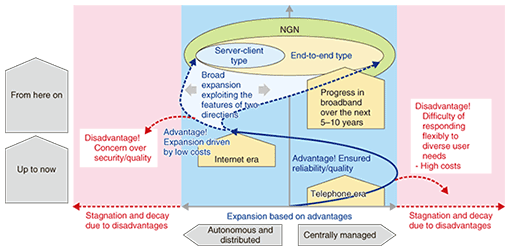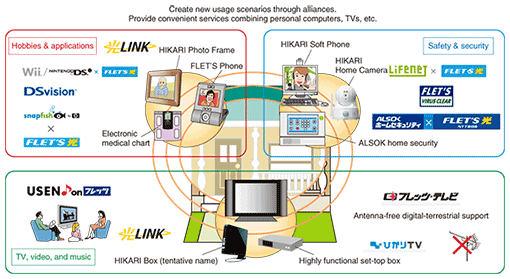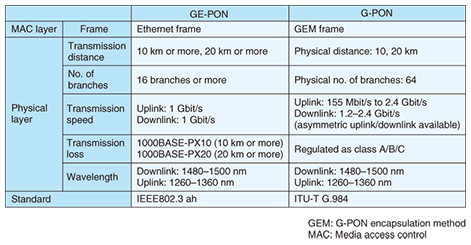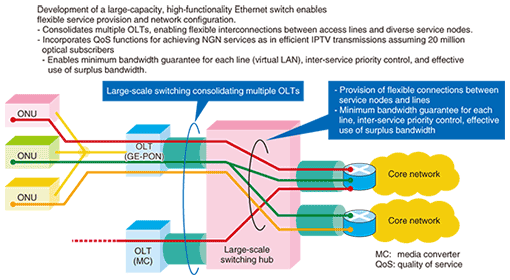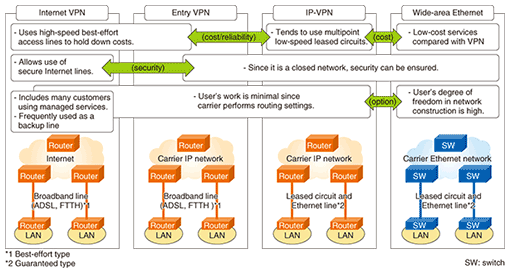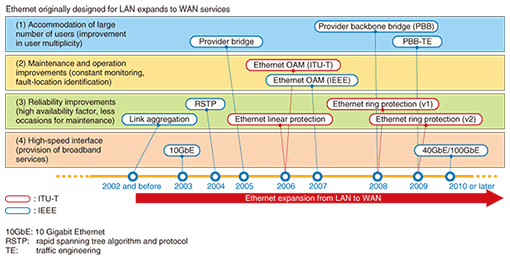 |
|||||
|
|
|||||
|
Special Feature: NTT Tsukuba Forum 2009 Workshop Lectures Vol. 8, No. 5, pp. 17–23, May 2010. https://doi.org/10.53829/ntr201005sf3 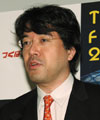 Optical Access Trends Driving NGN ExpansionAbstractThis article introduces technologies that support high-quality and high-reliability triple-play services on the Next Generation Network (NGN) and describes current trends in next-generation Ethernet systems. It is based on a lecture given in Japanese at the NTT Tsukuba Forum 2009 workshop held on October 15, 2009.
1. IntroductionThe penetration of broadband services has increased rapidly in recent years and the number of subscribers already exceeds 30 million. It appears that broadband services will soon overtake fixed-line telephone services, which have already entered a period of decline. In fact, if we break down broadband services, fiber-to-the-home (FTTH) subscriptions, which now exceed 15 million lines, overtook DSL (digital subscriber line) in June 2008, and if we restrict ourselves to NTT’s FTTH, the number of subscribers broke through the 10-million level in September 2008. From a global perspective, FTTH is expanding, with Japan taking the lead, followed by various countries in Asia and the USA. At the end of fiscal year 2007, Japan had the most subscribers at 12.5 million, so with China occupying second place at 6 million and Korea third place at 5 million, Asia ranks top in FTTH. The USA, while somewhat behind in deploying FTTH, is expected to show rapid growth in the years to come by using triple-play services to jumpstart an expansion. The Japanese information and communications technology environment is admired throughout the world for its prices, speed, security, and quality. To give an example, the results of a country-by-country survey on broadband quality overseen by Oxford University revealed that Japan’s broadband quality is on a significantly higher level than that of other countries. On the other hand, the results of a survey conducted within Japan revealed that Internet usage is low among the elderly in the 70+ age bracket, among low-income families with an annual income of under 2 million yen, and among residents of small towns and villages. Stimulating demand among these demographic groups is an issue to be addressed. Looking back at the history of the communications network, we see that the expansion period of the telephone network, the origin of today’s network, was dominated by the pursuit of reliability and quality above all else. As a result, a centrally managed system was constructed while importance was put on service efficiency. However, focusing too much on centralized management can raise costs and prevent a flexible response to the diverse needs of users. Thus, there was a shift to autonomous and distributed Internet-based services, which are known for their low cost and flexibility. However, as the Internet expanded and the user’s degree of freedom increased, concerns about security and quality arose and the need for high-security, high-quality network services came to be felt. Leaning too far toward either of the above service characteristics–centrally managed or autonomous and distributed–is undesirable. That leads to more disadvantages with the potential for stagnation and decay. The Next Generation Network (NGN), on the other hand, is intended to provide a service framework that combines the strong points of both the telephone network and the Internet (Fig. 1).
The NGN consists of network services providing both high quality and high reliability. (1) Ensuring quality: In addition to conventional best-effort-type communications, the NGN also provides priority-class communications that ensures a high level of quality. This is achieved by a mechanism in which a session control server identifies the type of terminal being used and secures a level of communications quality appropriate for that terminal. (2) Ensuring reliability: From the start, the Internet has been used to connect individual entities having their own intentions and purposes, and this inherent characteristic has made it difficult to secure sufficient reliability. The NGN, in contrast, sets node positions and selects paths through a comprehensive design based on a total policy, enabling a high level of reliability on par with that of the fixed telephone network to be achieved. At present, alliances are being actively cultivated toward expanded use of the NGN, and NGN-based services are being developed from diverse perspectives. Among these services, the market for optical-fiber-based video services is expanding rapidly. The number of subscribers to NTT’s services (FLET’S TV and HIKARI TV) is estimated to reach about 1.4 million by the end of fiscal year 2009 (Fig. 2).
2. Optical access technologiesAn optical access network that connects optical line terminals (OLTs) at the provider’s central office and optical network units (ONUs) on user premises is required to provide high reliability and economy as well as prompt response to service demands. The wiring formats can be divided into two main types: single star makes one-to-one connections between OLTs and ONUs and double star makes one-to-many connections between an OLT and several ONUs. The latter format can also be divided into active double star, which uses optical/electrical conversion equipment, and passive double star, or passive optical network (PON), which uses an unpowered splitter. In terms of operating the medium efficiently and keeping transmission costs down, PON is regarded as being the superior system. NTT is using the PON system for FTTH services such as Family Type and Multi-Dwelling-Unit Type (excluding VDSL/LAN systems (VDSL: very-high-speed digital subscriber line, LAN: local area network)) targeted at many ONUs. Ever since PON research and development began in 1986, PON systems have been becoming faster and more economical, but they have nevertheless been limited by conventional frame transfer using asynchronous transfer mode. However, with the development of GE-PON (Gigabit Ethernet PON) using Ethernet frames, services can now be provided at bidirectional speeds of 1 Gbit/s. Gigabit-per-second-class PONs come in two types: GE-PON and G-PON (Gigabit capable passive optical network) standardized by IEEE (IEEE802.3 ah) and ITU-T (International Telecommunication Union, Telecommunication Standardization Sector), respectively (Table 1) [1]. The GE-PON system has been studied as an expanded version of the Ethernet system. It targets Ethernet-based services, and since it is based on the Ethernet, it enables Ethernet frames to be transmitted and received in that form. This leads to simple equipment and also allows the use of reasonably priced Ethernet components developed for LAN systems. For these reasons, the GE-PON system provides excellent economy. At the same time, the G-PON system has been developed under the premise of accommodating telephone lines and leased circuits in addition to Ethernet schemes. While there is a tendency to make comparisons between GE-PON and G-PON, they have been different systems from the very start, and as compatibility cannot necessarily be guaranteed, it is appropriate to select one or the other. In Japan and elsewhere in Asia, GE-PON is overwhelmingly dominant, but in Europe and the USA, G-PON is mainstream.
3. Technologies supporting triple-play servicesTriple-play services on the NGN provide three key services (telephony, high-speed Internet, and TV) via one optical fiber. At NTT, these services are being developed using two types of systems: radio frequency (RF) for FLET’S TV and Internet protocol (IP) for HIKARI TV. Each of these systems has advantages and disadvantages. The greatest advantage of the RF system is that the signals it transmits are the same as those of digital-terrestrial and satellite broadcasts, which means that existing facilities and terminals may be used in their present form. The IP system, on the other hand, requires a converter, but its outstanding feature is that it is location-free in principle, making it applicable to services aimed at a small number of users. In the USA, it is being used to broadcast niche content to a relatively small number of users spread out over a wide area. The RF system requires viewers to be somewhat concentrated. The following technologies are being developed and expanded to provide triple-play services. (1) Broadband communications technology The GE-PON system can provide economic, high-speed, broadband communication services. In October 2009, NTT launched a high-speed service that raised the maximum communications speed from 100 Mbit/s to 200 Mbit/s as a new menu item for FLET’S HIKARI Next services. (2) Minimum-bandwidth-guarantee technology and inter-service priority control technology GE-PON bandwidth shared by multiple users is dynamically divided up according to usage conditions on each access line so that the bandwidth in the uplink direction can be controlled in a fair manner and a minimum bandwidth can be guaranteed on each line. Communication priority can also be set and controlled so that communications sensitive to delay like audio and video broadcasts can be given priority. In addition, the development and introduction of a large-capacity, high-functionality switching hub that consolidates multiple OLTs can provide a flexible network configuration. Here, the flexible interconnection of service nodes and lines via this switching hub can facilitate the provision of minimum bandwidth guarantees and priority control and the effective use of surplus bandwidth (Fig. 3).
(3) Video transmission and signal-processing technologies via the RF system NTT is developing FM (frequency modulation) batch conversion and transmission technology to convert multichannel video signals to a broadband FM signal that can then be converted to optical signals for distribution to user homes. Converting video signals to an FM signal makes the system more robust to noise and distortion, enabling the provision of high-quality video services. The transmission bandwidth can be expanded to 2072 MHz to support 110° CS (communication satellite) digital broadcasting, enabling the provision of CS digital services. (4) Efficient video delivery technology via the IP system NTT is also developing PON multicast functions to achieve efficient video delivery. These functions will perform multicast delivery of high-quality IP broadcasts to ONUs, enabling more effective use of the PON downlink bandwidth compared with existing multicast-delivery techniques. The use of PON technology also has a significant power-reduction effect. Preliminary calculations show that a PON system for 20 million FTTH optical subscribers will enable power savings equivalent to one small-scale nuclear power plant compared with a DSL system. 4. Next-generation Ethernet systemsNTT is moving forward with the research and development of next-generation Ethernet technologies for application to wide area network (WAN) services as NGN services for the business community. WAN services have made the transition from a leased-circuit and frame-relay era to low-cost high-speed virtual private networks and wide-area Ethernet systems. The main WAN services in use today are shown in Fig. 4.
Ethernet technology, which was originally developed for LAN systems, has undergone new expansion in conjunction with its application to WAN services. Major improvements accompanying this expansion to WAN are summarized below (Fig. 5).
(1) Accommodation of a large number of users (improved user multiplicity) (2) Maintenance and operation improvements (constant monitoring and fault-location identification) (3) Reliability improvements (higher availability and fewer maintenance needs) (4) High-speed interface (provision of broadband services) In particular, as next-generation Ethernet technologies, three network technologies have been developed to achieve high reliability and improve maintenance and operation characteristics and operation technology for administering those technologies.
5. ConclusionCommercial NGN triple-play services are expanding steadily and new multifaceted services are being created. This article introduced technologies supporting triple-play services and next-generation Ethernet technologies essential to further NGN expansion. Reference
ProfileCareer highlightsProject Manager, First Promotion Project, NTT Access Network Service Systems Laboratories. Munetake Otsuka assumed his current position with NTT Access Network Service Systems Laboratories in July 2009. He is leading the teams developing optical access systems for the mass market, such as passive optical networks, L2 switches, video distribution systems, and related operation systems. Since joining Nippon Telegraph and Telephone Corporation (NTT) in 1985, Mr. Otsuka has held numerous engineering posts in his 25-year career with the company, developing his expertise in transmission systems technologies for diverse networks and switches. Prior to his current assignment, he had been General Manager, Planning and Product Management, Innovative IP Architecture Center of NTT Communications Corporation, a long-distance and international service arm of NTT, from 2006 to 2009, where he engaged in corporate R&D management. While Mr. Otsuka engaged in research and development activities on various transmission systems in NTT labs, he served as Chairman of Working Group 1-2, Telecommunications Technology Committee, standardizing telecommunication technologies on inter-network interconnections from 1998 to 2003. Beyond engineering ventures, Mr. Otsuka also has hands-on management experience at NTT Hong Kong Limited as the organization’s Director and General Manager between 1995 and 1997. And he headed the Engineering section at NTT America Inc. as Vice President between 2003 and 2006. Through his experiences in a wide range of research and development initiatives, Mr. Otsuka has established his reputation as a dedicated engineer who has the ability to devise creative solutions while diligently managing available resources and timelines throughout the projects. A leader blessed with strong skills to listen and communicate, he has been recognized as a master at motivating his people for optimal results. Mr. Otsuka graduated from the University of Tokyo with a Bachelor of Engineering degree in 1983 and a Master of Engineering Degree in 1985. He completed the Program for Management Development at Harvard Business School in 2002. Mr. Otsuka co-authored “Joho Tsushin Hayawakari Koza 4” published in April 2001 in Japan. |
|||||








